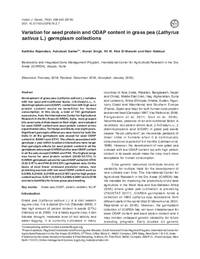Variation for seed protein and ODAP content in grasspea (Lathyrus sativus L.) germplasm collections

Authors:
Development of grass pea (Lathyrus sativus L.) varieties with low seed anti-nutritional factor, β-N-Oxalyl-L-α, βdiaminopropionic acid (ODAP) content but with high seed protein content would be beneficial for human consumption. In this study, a total of 702 germplasm accessions, from the International Center for Agricultural Research in the Dry Areas (ICARDA), Syria, were grouped into seven sets of trials based on their origin, and evaluated for seed ODAP content and seed protein content at two experimental sites, Tel Hadya and Breda over eight years. Significant genotypic differences were found for both the traits in all the germplasm sets except for seed ODAP content in BANG1 and ETH1. The effects associated with genotype × year within locations interactions were larger than genotypic effects for seed protein content in all the germplasm sets except ICARDA and for seed ODAP content in all the sets except ICARDA and PAK. The highest range was found for seed protein content (28.82-30.72%) in ICARDA germplasm set and for seed ODAP content in ETH2 (0.32-0.47%) and PAK (0.38-0.53%) germplasm sets. On the basis of best linear unbiased predictor values, new promising sources with low seed ODAP content such as ILG468, ILG1934, ILG1950 and ILG1951 and for high protein content such as ILG311, ILG670, ILG688, ILG691 and ILG708 and were identified for future grass pea breeding.
